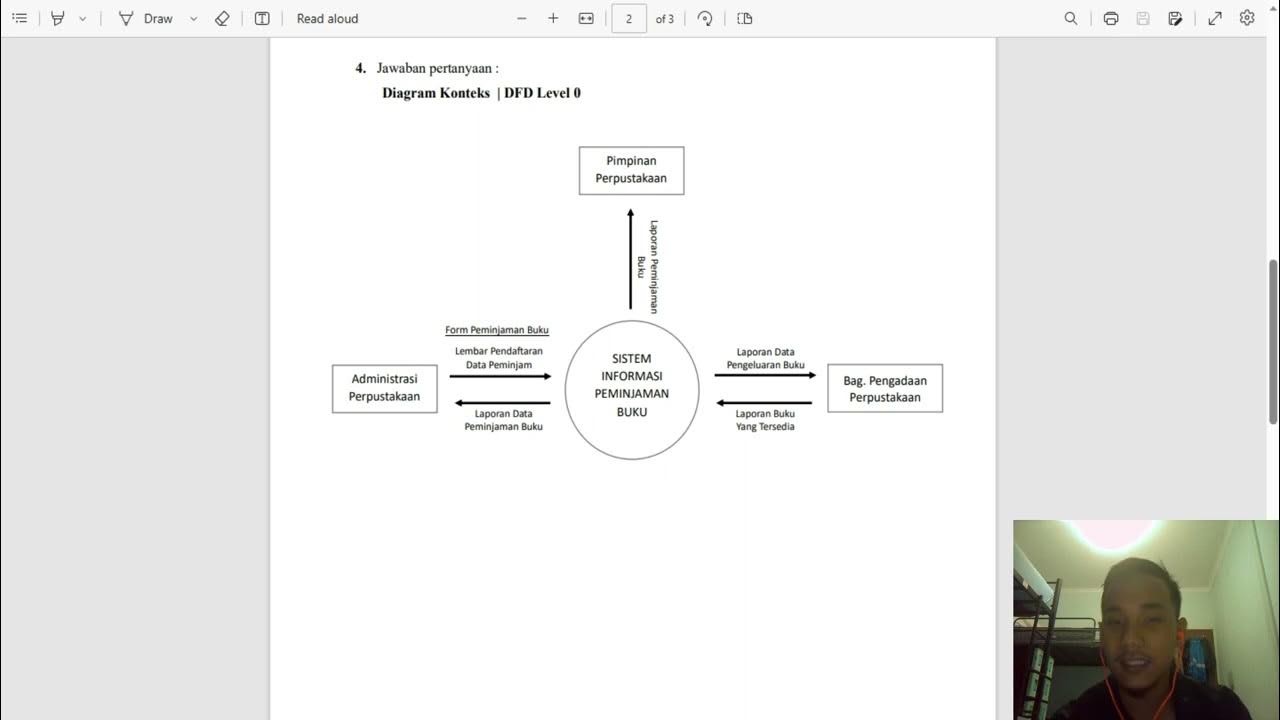What is a Data Flow Diagram and Why Do You Need One?
Summary
TLDRThe data flow diagram (DFD) illustrates business processes at various levels of detail. Some processes may be broad, while others are specific. DFDs can be 'exploded' to reveal internal processes for greater clarity. The diagram serves multiple purposes, such as identifying roadblocks, improving efficiency, and communicating stakeholder requirements for IT projects. It helps in presenting, analyzing, and discussing processes effectively, as visuals are proven to be more impactful than words. Moreover, DFDs spark curiosity, leading to further investigations and uncovering potential issues.
Takeaways
- 😀 A data flow diagram (DFD) represents a business process at various levels of detail, ranging from high-level overviews to very specific processes.
- 😀 Processes in a DFD can be exploded into sub-processes to reveal internal processes if a deeper understanding is needed.
- 😀 The DFD does not differentiate between levels of detail; sub-processes are simply lower-level processes that consume or create specific data.
- 😀 Detailed data flows and data stores are visible when a DFD is drawn at a more specific level.
- 😀 Any process in a DFD can be exploded for further detail, with the only consideration being whether the process is understood sufficiently to predict the impact of changes.
- 😀 A DFD can serve multiple purposes: analyzing current processes, presenting and discussing processes with others, or identifying potential issues before developing detailed processes and IT applications.
- 😀 One primary use of a DFD is to identify, document, and communicate stakeholder requirements for an IT project.
- 😀 Visual communication through DFDs is more effective than verbal descriptions, making it easier to discuss processes and flows.
- 😀 DFDs generate curiosity and questions that help identify missing steps or external entities, which is valuable for improving the understanding of the process.
- 😀 The DFD is a powerful tool in identifying roadblocks, improving efficiency, and helping ensure a comprehensive understanding of the process from multiple perspectives.
- 😀 The principal benefit of DFDs is the ability to visually represent and communicate processes, which enhances clarity and facilitates problem-solving.
Q & A
What is a Data Flow Diagram (DFD)?
-A Data Flow Diagram (DFD) is a visual representation that illustrates how data flows through a system. It shows processes, data stores, and external entities involved in the flow of information.
What is meant by 'exploding' a process in a DFD?
-'Exploding' a process in a DFD refers to breaking down a high-level process into more specific internal processes and data flows to provide a detailed view of how the process works.
Why might a DFD include processes at varying levels of detail?
-A DFD includes processes at varying levels of detail to capture both broad, global processes and more specific, internal processes. This flexibility allows users to zoom in on areas that require more detail and understanding.
How does a DFD help in identifying roadblocks and inefficiencies in a business process?
-By visualizing the flow of data and interactions between processes, a DFD allows users to spot potential bottlenecks, inefficiencies, and gaps, helping to improve overall process efficiency.
What is the principal use of a DFD in an IT project?
-The principal use of a DFD in an IT project is to identify, document, and communicate stakeholder requirements. It serves as a tool to understand how systems work and what changes may be needed.
How does a DFD improve communication during the discussion of business processes?
-A DFD improves communication by offering a visual representation of a process, which is more effective than describing the process using words alone. This visual mode of communication enhances clarity and understanding.
What role does a DFD play in analyzing a current business process?
-A DFD helps analyze current processes by providing a detailed visual map that highlights areas where improvements are needed, enabling stakeholders to evaluate the process thoroughly and identify areas for change.
What is the benefit of creating a DFD for a proposed business process?
-Creating a DFD for a proposed business process helps identify potential issues before they occur, allowing teams to plan for solutions and avoid complications during development.
How does the visual nature of a DFD enhance the understanding of a process?
-The visual nature of a DFD allows for an immediate understanding of how data flows and interacts within a system, providing a clear overview of processes and their relationships, which is often more intuitive than verbal descriptions.
What are the advantages of using a DFD over a written description of a process?
-A DFD offers a visual representation that is more efficient and effective in conveying complex information, making it easier for stakeholders to understand and analyze processes, identify gaps, and collaborate on improvements.
Outlines

This section is available to paid users only. Please upgrade to access this part.
Upgrade NowMindmap

This section is available to paid users only. Please upgrade to access this part.
Upgrade NowKeywords

This section is available to paid users only. Please upgrade to access this part.
Upgrade NowHighlights

This section is available to paid users only. Please upgrade to access this part.
Upgrade NowTranscripts

This section is available to paid users only. Please upgrade to access this part.
Upgrade NowBrowse More Related Video

What is DFD ? Full Explained With Example Library Management System DFD | Don't Miss

Diagram Konteks | DFD Level 0 dan DFD Level 1 | Sistem Informasi Peminjaman Buku

Tutorial Membuat DFD (Data Flow Diagram) | Studi Kasus Koperasi

Data Flow Diagram (DFD): Definisi, Sejarah, Notasi, Tahap dan Tipsnya.

#Matakuliah RPL | Pemodelan Proses (DFD)

Chapter 7 Session 4 Part II: Stonehurst Place Example: Connecting Human Interfaces and DFD-0
5.0 / 5 (0 votes)